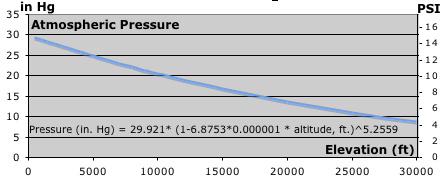- Take it easy for the first 24-48 hours. At 6,000 ft. 12 hrs may be enough. The effects of hypoxia (an oxygen deficiency) will make it difficult to exercise and can lead to Acute Mountain Sickness (AMS).
At FamilyDoctor.org they say:
"When you reach an altitude above 8,000 feet, don't go up faster than 1,000 feet per day."
- Take frequent breaks when exercising because of the thin air.
- Solar intensity increases 6% for every 1,000 ft at the same latitude, so at 5,000 ft is is 30% more, 8,000 ft 48% more etc.; Use sunglasses/goggles with a light transmission factor of 9-15%, hats and sun block with SPF 30-50. Low humidity at altitude also dries the skin making it more prone to burning and long-term skin damage.
- temperature drops 3-4° for every 1,000 ft elevation gain.
- Drink 6-8 glasses of water a day to avoid dehydration, which already occurs faster due to the marked dryness of the high mountain air, combined with the increased breathing rate from less oxygen. This is a major cause of altitude sickness..
See Hydration under health.
- Avoid alcohol which is a diuretic causing dehydration because:
1. The kidneys take time to filter out large quantities of water to break down the alcohol.
2. It halts the production of the body's anti-diuretic hormone.
Both result in more frequent urination and so speeding up the loss of fluid from your body.
Alcohol also dilates peripheral blood vessels which may make you feel warm, but actually contributes to heat loss and the risk of hypothermia.
If you do drink alternate alcoholic drinks with non-alcoholic ones.
See Alcohol under health.
- Some people also consider caffeine a diuretic, but it does not affect hormone's the way alcohol does. It weakens the detrusor muscles in the bladder, which provokes the need to urinate.
See www.vanderbilt.edu/AnS/psychology/health_psychology/caffeine_sports.htm
- Weather changes VERY quickly at high altitude, so cary extra clothing.
- Carbohydrate is the preferred energy source at altitude. Carbohydrates replace depleted muscle glycogen stores, prevent protein from being used as energy, and require less oxygen for metabolism. Avoid high-fat foods such as cheeses, summer sausage, and jerky.
Potassium is especially helpful to physiological maintenance at greater heights. So, eat foods such as broccoli, bananas, avocado, cantaloupe, celery, greens, bran, chocolate, granola, dates, dried fruit, potatoes, tomatoes.)
- Water boils at a lower temp (202° at Denver), so cooking will take longer.
- Hypoxia is the effects of an insufficient supply of oxygen to the body. Every person can have different symptoms when suffering from hypoxia (U.S. Air Force aircrews are required to take an altitude chamber ride every three years to reinforce and identify their hypoxic symptoms). Some of the common symptoms are: lightheaded sensation, dizziness, reduced vision, and euphoria.
The Time of Useful Consciousness is a function of altitude. (Assuming you are in a plane which looses pressurization):
20,000' 5-12 min.
25,000' 3-5 min.
30,000' 1-2 min.
40,000' 9-15 sec.
- High Altitude and the Heart - Quickly ascending to a high altitude can challenge the healthiest people, but it can spell extra trouble for individuals with a heart problem, according to the July 2008 Harvard Heart Letter. They say:
"If you've had a heart attack, bypass surgery, or angioplasty, and your heart function is good, or you have well-controlled angina, you should be able to handle a high-altitude trip. If you plan to hike, ski, or do another strenuous activity, make sure you are able to do similarly stressful activities at home."
"Blood pressure tends to increase at higher elevations, so it's best to get blood pressure under control before traveling. "
See also: DHMC Cardiology: High Altitude and the Heart at Dartmouth Hitchcock Medical Center
and Coronary heart disease at altitude. from the
National Center for Biotechnology Information (NCBI) at the National Institutes of Health (NIH).
See Links below for more detail.
Air density as a function of altitude.

There are more complicated formulas which take into account temperature variation.
|
Altitude
(ft) | Pressure
(in Hg) | PSIA | Boiling
° F |
| 0 | 29.9 | 14.70 | 212.0 |
| 5,000 | 24.9 | 12.23 | 203.0 |
| 7,500 | 23.1 | 11.35 | 199.3 |
| 10,000 | 20.6 | 10.10 | 193.6 |
| 15,000 | 16.9 | 8.29 | 184.2 |
| 18,000 | 15.0 | 7.37 | 181 |
| 20,000 | 13.8 | 6.76 | 175 |
| 27,000 | 10.2 | 5.02 | 168 |
| 50,000 | 3.4 | 1.69 | |
| 100,000 | 0.33 | 0.16 |
PSIA - Pounds per square inch absolute
|
There are several units for measuring atmospheric pressure, [values at sea level]: Atmosphere (1 atm), Pounds per square inch (14.70 psi), Inches of mercury (29.92 inHg), bars (1 bar), millibars (1013 mb), kilopascals (101.3 kPa).
Air density at 18,000 ft is about 1/2 of that at sea level; At the top of Mt. Everest (29,028') it is a little less than 1/3 that at sea level.
In the Death Zone, above 8,000 m (26,000') your body can not metabolize food and starts eating itself.
Water boils at lower temperatures in thin air; Boiling temperature drops about 1 degree for each 500-foot increase in elevation.
See water sterilization
Changes in barometric pressure due to weather has a small effect also. The normal extremes are about the same as a 1,000' change in elevation.
|
 Recreation
Recreation
 Hiking and Camping
Hiking and Camping
 High Altitude Guidelines
High Altitude Guidelines
 Recreation
Recreation
 Hiking and Camping
Hiking and Camping
 High Altitude Guidelines
High Altitude Guidelines
